To maximize the performance of EMIS Web there are a number of activities that you should regularly undertake.
In order to view all active tasks across your organisation, relevant users will need to be configured as global viewers for all Workflow Manager inboxes in order to see the total number of active tasks in each one.
This guide is not exhaustive but covers the key elements that need to be checked/maintained on a regular basis.
We will keep this guide up to date over time and will periodically share it with you directly.
Hardware
It is essential that regular checks are performed on your hardware to ensure they are able to run EMIS Web to optimum levels.
Some of the checks listed below can be carried out by users but others will need to be performed by whichever provider manages your local IT equipment or infrastructure.
Where this article references 'It Support', your local IT provider will be LIVI IT Support
Please ensure that relevant support queries are raised at https://ask-it.kry.se/hc/en-us
Does your hardware meet the recommended specification?
In order to ensure optimum performance in EMIS Web, please ensure that your hardware and software meet the recommended specification.
Please be aware that although the minimum requirements will enable EMIS Web to run, the minimum specification does not take into account other software that may be installed on your machine such as Microsoft Teams.
The most common factors that can impact the performance include:
- Less than 10GB of free disk space on the hard disk
- Less than 16GB RAM
- Running memory intensive software such as Microsoft Teams, Slack and Chrome
- Multiple Instances of EMIS Web Open
- Multiple Chrome Tabs open
- Slow Internet Bandwidth
- An excess number of active tasks within EMIS Web
- EMIS Web Resources (Templates, Protocols, Searches)
- Microsoft Defender for Endpoint
How to check your free disk space
You should regularly check that your terminal meets the minimum requirement of at least 10% free disk space with a minimum of 10GB.
- Click the folder icon on your Windows Taskbar to open a File Explorer
- On the left-hand menu, click This PC
- Under Devices and Drives, check the Windows (C:) icon and beneath this you will be able to view the amount of free disk space.
The example below shows a laptop with 107 GB of free disk space which therefore would meet the minimum requirement.
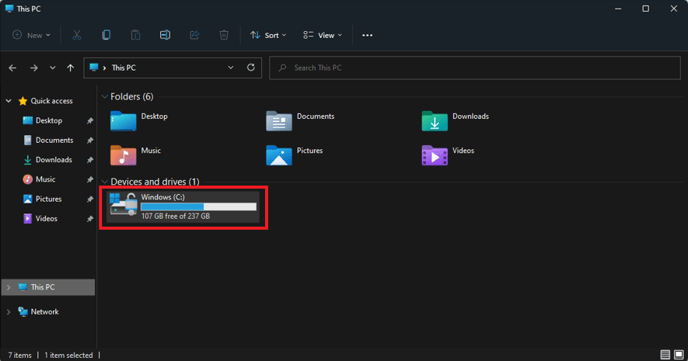
If you do not have the relevant permissions to check the size of your Windows (C:) drive, please contact IT Support.
How to check the RAM specification on your machine
8GB of dedicated RAM is required to run EMIS Web and it's other EMIS-X components at optimum levels. Any additional applications installed and in use will result in an increase in the RAM required on the machine.
As LIVI run memory intensive software such as Microsoft Teams, Slack and Chrome the recommended minimum RAM should be 16GB
It is important to check that your machine has enough physical memory to support all the software it is running (i.e. not just EMIS Web).
- Click the Windows Start Menu and select Settings
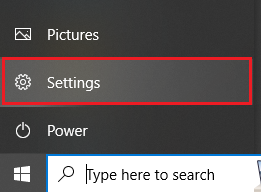
- From the Settings menu, select System and then scroll down and select About
- The RAM will be displayed under Installed RAM. The example below shows a laptop with 8GB of RAM which is enough to run EMIS Web but if other software was being used, as is the case with LIVI, performance would be impacted.

If your laptop only had 8GB Installed RAM (as above) please report this to IT support
Avoid Running multiple EMIS Web Instances at the same time
Having more than one instance open of EMIS Web on your machine may cause performance issues and is not typically recommended.
This may also happen inadvertently if another EMIS Web session has not been closed down properly. This can then cause your system to run slower than you would expect.
To check if you have any additional EMIS Web sessions running in the background, access the Windows Task Manager: press the CTRL+ALT+DEL keys, select Task Manager, select the Details tab then check for any entries named 'EmisWeb.exe'.
You can end any EmisWeb.exe processes you find by right-clicking on them and selecting End Task.
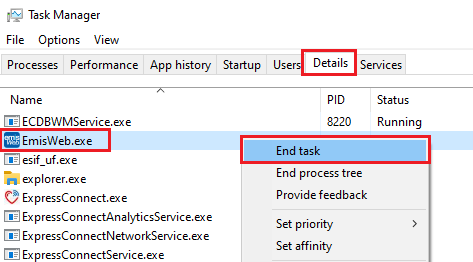
Once all sessions have been ended, restart EMIS Web and log on as normal.
Avoid having multiple Chrome tabs open
Chrome is a very memory intensive software application and the more tabs you have open the more memory it takes up on your laptop which may also impact on the performace of EMIS. Below is an example of how much memory is used when multiple Chrome tabs are open:
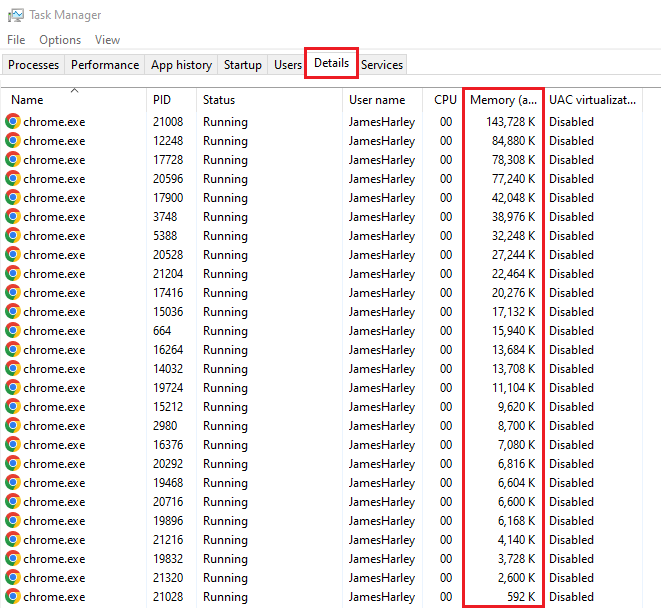
Use Task Manager to see what other applications may be using high amounts of memory and close these if possible (right click > Quit)
Closing memory intensive software such as Microsoft Teams, Slack
Sometimes it may be necessary to close memory intensive software applications such as Microsoft Teams, Slack especially if your device only has 8GB of RAM. Applications such as Microsoft Teams and Slack must be closed completely from the Task Tray. Select the Hidden Icons arrow from the Task Bar, right click on the application icon (example below is Teams) and select Quit:
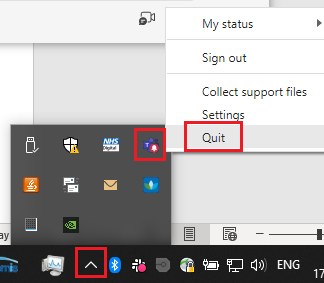
Check your Internet connection
You can perform a basic speed check of your local network if EMIS Web is running slowly. Follow the instructions in the broadband performance tester to check that your internet connection is running at an ideal speed for EMIS Web to operate.
The minimum download and upload speed for EMIS Web to function is 2 mb/s. If you find that your network speed is below this, contact your Home Broadband Provider or local IT team (if working out of a GP Practice/Hospital etc) and advise them that your local network is causing performance issues.
Working from Home - things to try
- Are there other people in your home who may be using some of the broadband bandwidth for gaming and streaming videos (YouTube, Netflix, Amazon Prime etc)? If so ask them to come off and test the performance again. If you're up to it read this article around how you can improve your Internet Speeds.
- Try plugging your laptop directly into the router using an Ethernet Cable rather than using the Wireless Network.
- Close any applications that you do not need opwn on your laptop (i.e. Microsoft Applications such as Word, Excel)
EMIS Tasks
An excess number of active tasks within EMIS Web can cause degraded system performance.
This includes active tasks in any area of Workflow Manager, not just the Tasks inbox.
Tasks should be managed on a daily basis to prevent an excess building up over time. Where possible, inboxes should be cleared of active tasks each day to ensure optimal performance of EMIS Web.
Although archiving tasks is good housekeeping, as long as tasks are completed, they will not negatively impact performance of EMIS Web. Large volumes of active tasks have shown to cause system slowness and KD errors.
In order to view all active tasks across your organisation, relevant users will need to be configured as global viewers for all Workflow Manager inboxes in order to see the total number of active tasks in each one.
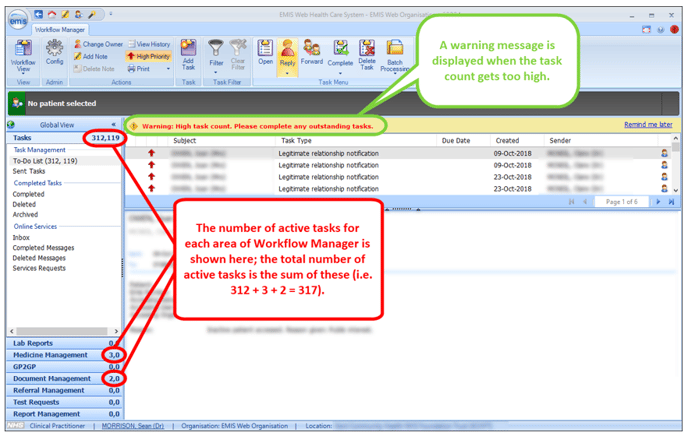
Performance may also be impacted if tasks are left to build up over the course of the week and then actioned all at once at the end of the week.
Managing EMIS Web resources
EMIS Web can be used to create a variety of different resources that help you standardise and report on data inputted into the system. These resources are:
- Clinical Templates
- Concepts
- Protocols
- Searches
EMIS have noticed that over time, organisations are building up a considerable amount of resources, including a large number that are no longer in use, or newer versions have been created.
All of these resources increase the demand on the system, and in some cases, may contribute to system slowness.
It is possible to improve overall system performance whilst undertaking some basic housekeeping tasks.
We recommend the following best practice guidance:
When creating new resources
- Consider whether resources need to include multiple components, such as library items. Can a template be split into smaller templates so only the relevant parts are run? This would prevent a large template from being run unnecessarily.
- If you cannot split a resource into smaller resources, consider saving multiple large resources in separate folders.
When amending existing resources
- If a new version of a template is created, consider overwriting the existing resource instead of creating a new version.
- Where access to previous versions is required, consider exporting a copy and saving it locally on a shared drive instead of on EMIS Web.
- If a resource is no longer required, archive (templates, protocols and concepts) or delete it (searches only).
- Complete a regular review of any resources such as searches that may have been created as a one-off but is no longer required, and delete where appropriate.
Protocols and triggers
- EMIS recommend you undertake regular reviews of your active protocols and their triggers and consider the following:
- Are you using load patient as the trigger for the protocol rather than specific activities such as book appointment/issue drug?
- Does your protocol have a clear end and does not loop on itself? (A basic example is having a protocol that opens a consultation set to trigger when a consultation is saved, which then opens a new consultation).
Microsoft Defender for Endpoint
Managing what Microsoft Defender excludes from its scans will be the responsibility of the IT Department.
Microsoft anti-virus software provides real-time protection for files and processes on a Windows 10 desktops with the service activated.
During investigations with several customers, EMIS have observed high background CPU usage for the anti-malware service (MSMpEng.exe) and spikes in CPU usage when operating EMIS Web.
They have observed that excluding certain EMIS and Partner product processes from the real-time scanning engine eliminates the performance degradation in the use of EMIS Web.
Microsoft have provided options for configuring exceptions for the real-time scanning service.
Adding exceptions to any security software should be subject to a local risk assessment and approval. By excluding certain folders or processes from protection or scanning it is possible for a malicious party to impersonate a process or add items to a folder. The likelihood and threat potential will vary from setting to setting and should be considered on a case by case basis.
Processes to exclude
- emisweb.exe
- emis.host.client
- emis.mkb.host.exe
- sds.client.windowsservice.exe
- cefsharp.browsersubprocess.exe
- igpr.exe
- accurx.host.exe
- add additional partner product processes according to local use
Folders to exclude
- %PROGRAMDATA%\SDS\*
- %PROGRAMDATA%\EMIS\*
- %PROGRAMDATA%\NICHE\*
- %PROGRAMFILES(x86)%\ACCURX UPDATER\*
- Add additional partner products folders according to local use
Further advice can be found on EmisNow here.
